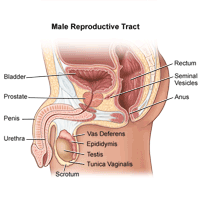Prostate Disease
Facts about the prostate gland
The prostate is a sex gland in men. It's about the size of a walnut, and surrounds the neck of the bladder and urethra—the tube that carries urine from the bladder. It's partly muscular and partly glandular, with ducts opening into the prostatic portion of the urethra. It's made up of three lobes: a center lobe with one lobe on each side.

The prostate gland secretes a slightly alkaline fluid that forms part of the seminal fluid, a fluid that carries sperm.
Types of noncancerous prostate problems
Most clinical conditions of the prostate are benign (noncancerous), including the following:
-
Benign prostatic hyperplasia (BPH). This is an age-related enlargement of the prostate that isn't malignant. BPH is the most common noncancerous prostate problem, occurring in most men by the time they reach their 60s. Symptoms are slow, interrupted, or weak urinary stream; urgency with leaking or dribbling; and frequent urination, especially at night. Although it isn't cancer, BPH symptoms are often similar to those of prostate cancer.
-
Prostatism. This symptom of prostatism is decreased urinary force due to obstruction of flow through the prostate gland. The most common cause of prostatism is BPH.
-
Prostatitis. This is inflammation or infection of the prostate gland characterized by discomfort, pain, frequent or infrequent urination, and, sometimes, fever.
-
Prostatalgia (also called prostatodynia). This is pain in the prostate gland. It's frequently a symptom of prostatitis.
These problems are quite common and may happen to men of all ages. Prostatitis is mainly a problem of men younger than age 50, and BPH affects primarily men older than age 50.
For More Information
For more information or to schedule an appointment for a screening, please call 718-818-1234 or visit Richmond University Medical Center at 355 Bard Avenue, Staten Island, NY, 10310.
© 2000-2024 The StayWell Company, LLC. All rights reserved. This information is not intended as a substitute for professional medical care. Always follow your healthcare professional's instructions.